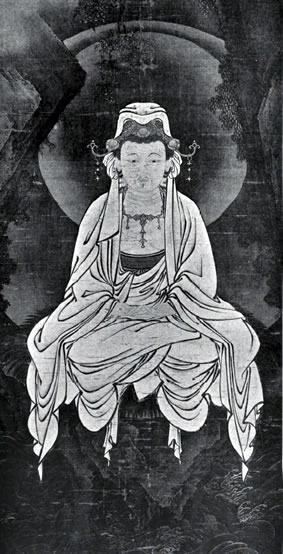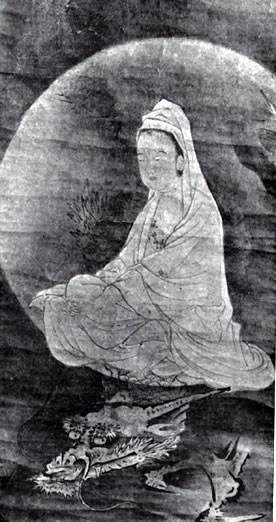The Zen Practice of Meditation
 Zen was a branch of Buddhism which laid special emphasis upon meditation. Its adherents believed that to them had been directly transmitted the spiritual illumination of Buddha, and they cultivated his method of meditation simply and purely, without admixture of mysterious rituals and doctrinal analysis. They had, moreover, inherited the nature- mysticism of the Indian Buddhists which, together with the poetry of the southern Chinese, became a source of inspiration for the artistic sense of the Japanese. The chief effort of this sect was directed toward the attainment of spiritual enlightenment through personal experience in contemplation, and the effects of this practice were shown in manifestations of strong individuality. At the same time a feeling for the tranquil beauty of nature produced a serene "air-rhythm" of transcendence over the incidents of human life. This somewhat paradoxical combination of individualism and transcendentalism resulted in an identification of spirit of the world, a state to be realized only through insight into the heart and spirit of nature. Passion, or even enthusiasm, is an impediment to this attainment and reason is useless; the essential is intuition, which illumines the mind like a flash in darkness, and pervades the whole air like moonlight.
Let me elucidate these points a little further.
Zen was a branch of Buddhism which laid special emphasis upon meditation. Its adherents believed that to them had been directly transmitted the spiritual illumination of Buddha, and they cultivated his method of meditation simply and purely, without admixture of mysterious rituals and doctrinal analysis. They had, moreover, inherited the nature- mysticism of the Indian Buddhists which, together with the poetry of the southern Chinese, became a source of inspiration for the artistic sense of the Japanese. The chief effort of this sect was directed toward the attainment of spiritual enlightenment through personal experience in contemplation, and the effects of this practice were shown in manifestations of strong individuality. At the same time a feeling for the tranquil beauty of nature produced a serene "air-rhythm" of transcendence over the incidents of human life. This somewhat paradoxical combination of individualism and transcendentalism resulted in an identification of spirit of the world, a state to be realized only through insight into the heart and spirit of nature. Passion, or even enthusiasm, is an impediment to this attainment and reason is useless; the essential is intuition, which illumines the mind like a flash in darkness, and pervades the whole air like moonlight.
Let me elucidate these points a little further.
The practitioner of Zen takes pride in the thought that his method is an unwritten tradition originally transmitted by Buddha to his great disciple Maha-Kasyapa, when the Master lifted a flower in his hand and the disciple responded to the impelled riddle with silence and a smile. What question this flower was meant to convey, or why it was answered by a smile can be realized only intuitively and in meditation. But the transmission itself is not based on Buddha's invention or on any artifice; it traverses the innermost recesses of the mind enlightened in the truths of nature, so that every Zenist should receive his spiritual illumination through the medium of his own soul, directly from the vast sources of the cosmos. All instruction is but as a finger pointing to the moon; and he whose gaze is fixed upon the pointer will never see beyond. Even let him catch sight of the moon, and still he cannot see its beauty unless his mind be innocent of passion and commotion. In order to commune heart to heart with the cosmos and see its reality as it is, he must first free himself from the interference of special concern and from the captivation of thought.
 KWANNON In the Style of Sesshu, 1420-1506 Japanese, Ashikaga Idealistic School In the Museum of Fine Arts , Boston Here the deity appears in feminine form, absorbed in meditation and seated on the back of a dragon. Painted in ink and traces of color on paper and mounted as a kakemono.
KWANNON In the Style of Sesshu, 1420-1506 Japanese, Ashikaga Idealistic School In the Museum of Fine Arts , Boston Here the deity appears in feminine form, absorbed in meditation and seated on the back of a dragon. Painted in ink and traces of color on paper and mounted as a kakemono.
His mind should be purged of such encumbrances, like the mind of one who loiters in the translucent air of night and enjoys the clear, serene moonlight, calmly and freely. This is the ideal of the Zenist, to be attained through spiritual exercise in meditation. The Zen practice of meditation is not a mode of deliberate reflection, not thinking in the usual sense, but consists rather in an evacuation of the mind, a process through which alone we can fully exercise our intuitive insight. What, then, is to be apprehended by that intuition? Here again our common sense stumbles and our thought is defied. A great master of Zen said: Is there obverse or reverse in transparent water? Is there inside or outside in vacant space? There is that which is luminous and clear, spontaneous and disembodied. Therein is no differentiation of forms and colors; no antithesis of object and subject. [It is] one and the same since eternity; no term to describe it, for ever." This it is that underlies our selves, our souls; this is the primordial essence of each and all existence. The same master says in another passage: ''See the high mountain. The summit is hidden; yet far beyond the clouds the eyes catch the height by which it is illumined. Look into the deep ocean. The bottom cannot be seen; yet the depth can be penetrated without taking thought. Silence is eloquent enough to make clear the essence; and even while sitting in repose the cosmos can be grasped. The whole being is bare and apparent; it is that of a colossus expanding beyond measure, — a giant without motion or emotion; no twilight can impede his vision, nor any dust besmirch his feet." Such is the true nature of the condition which is inherent in our own souls and is realized completely by the intuitive faculty of a mind trained in Zen. Suppose, then, that the mind has attained this ideal state of repose, — that it is quieted, poised, Liberated, so to speak, — what would be the view of life and the world seen in that condition.
tZen Art: Naturalism and Individualityvvvvvvvvvvvvvvvvvvvvvvvvvvvvvvvvvv v Zen Individualialism u
